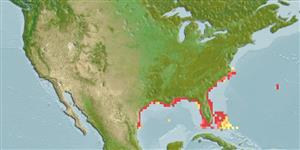>
Ophidiiformes (Cusk eels) >
Dinematichthyidae (Viviparous brotula)
Etymology: Gunterichthys: Because of Albert C. L. G. Günther, German ichthyologist, 1830-1914 (Ref. 45335).
Environment: milieu / climate zone / depth range / distribution range
Ökologie
seewasser; brackwasser demersal; tiefenbereich 0 - 9 m (Ref. 34024). Subtropical; - 24°N
Western Atlantic: northern Gulf of Mexico.
Size / Gewicht / Alter
Maturity: Lm ? range ? - ? cm
Max length : 7.5 cm TL Männchen/unbestimmt; (Ref. 7251)
Rückenflossenweichstrahlen (insgesamt): 60-71; Afterflossenweichstrahlen: 41 - 52; Wirbelzahl: 38 - 40. Diagnosis: Blunt snout; small distinct eyes, 1.4-1.9% SL in adults; head naked, body covered with imbricate scales; interorbital in adults 5.6-7.7% SL; posterior infraorbital pores 2; rays in dorsal fin 60-71, anal 41-52, caudal 12-15; otolith with fused colliculi; sulcus small; 1 pair of pseudoclaspers with 2 almost equally long supporters (Ref. 55786).
Burrows in soft mud bottoms at shallow depths (0.7-6 m) of quiet lagoons, backwaters and saline parts of estuaries (Ref. 7251, 55786). Reported to give birth to very few, about 15 mm long juveniles in each clutch; one female found to have four 5-8 mm long embryos and has a 3.2 mm bivalve in the intestine (Ref. 55786). Probably common where it occurs (Ref. 34024).
Life cycle and mating behavior
Geschlechtsreife | Fortpflanzung | Ablaichen | Eier | Fecundity | Larven
Nielsen, J.G., D.M. Cohen, D.F. Markle and C.R. Robins, 1999. Ophidiiform fishes of the world (Order Ophidiiformes). An annotated and illustrated catalogue of pearlfishes, cusk-eels, brotulas and other ophidiiform fishes known to date. FAO Fish. Synop. 125(18):178p. Rome: FAO. (Ref. 34024)
IUCN Rote Liste Status (Ref. 130435)
Bedrohung für Menschen
Harmless
Nutzung durch Menschen
Fischereien: nicht kommerziell
Mehr Information
NamenSynonymeMetabolismusRäuberÖkotoxikologieFortpflanzungGeschlechtsreifeAblaichenSpawning aggregationFecundityEierEientwicklung
ReferenzenAquakulturAquakultur ProfilZuchtlinienGenetikElectrophoresesVererbbarkeitKrankheitenVerarbeitungNutrientsMass conversion
PartnerBilderStamps, Coins Misc.LauteCiguateraGeschwindigkeitSchwimmstilKiemenoberflächeOtolithsGehirngrößeSehfähigkeit
Tools
Zusatzinformationen
Download XML
Internet Quellen
Estimates based on models
Preferred temperature (Ref.
123201): 23.3 - 26.8, mean 24.6 °C (based on 124 cells).
Phylogenetic diversity index (Ref.
82804): PD
50 = 0.6250 [Uniqueness, from 0.5 = low to 2.0 = high].
Bayesian length-weight: a=0.00389 (0.00180 - 0.00842), b=3.12 (2.94 - 3.30), in cm total length, based on all LWR estimates for this body shape (Ref.
93245).
Trophic level (Ref.
69278): 3.3 ±0.5 se; based on size and trophs of closest relatives
Widerstandsfähigkeit (Ref.
120179): niedrig, Verdopplung der Population dauert 4,5 - 14 Jahre. (Assuming Fec < 100).
Fishing Vulnerability (Ref.
59153): Low vulnerability (10 of 100).
